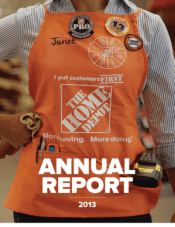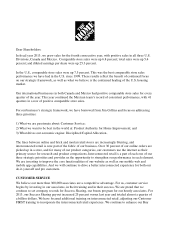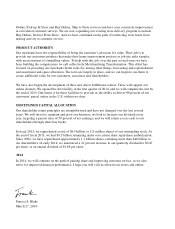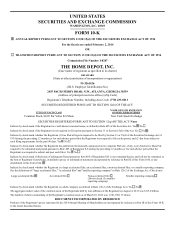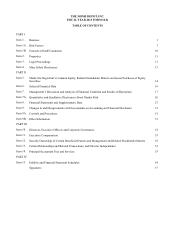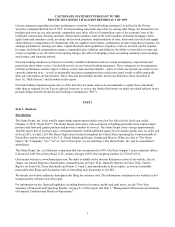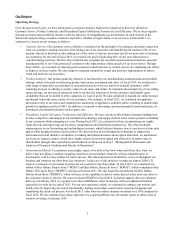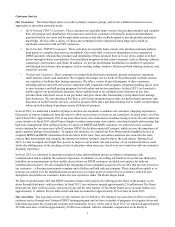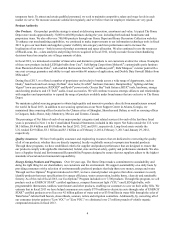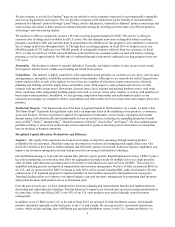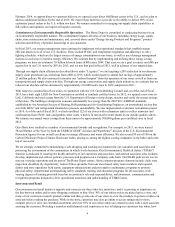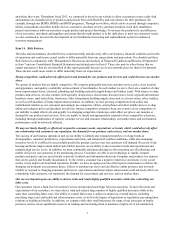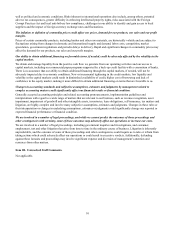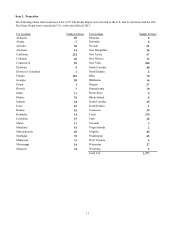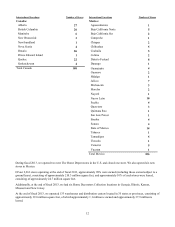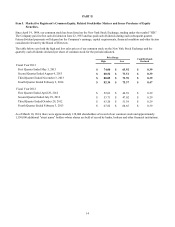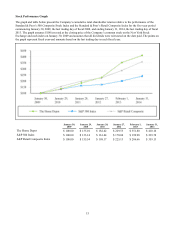Home Depot 2013 Annual Report Download - page 10
Download and view the complete annual report
Please find page 10 of the 2013 Home Depot annual report below. You can navigate through the pages in the report by either clicking on the pages listed below, or by using the keyword search tool below to find specific information within the annual report.
5
We also continue to use the Eco Options® page on our website to reach consumers interested in environmentally responsible
and cost-saving products and projects. The site provides consumers with information on the benefits of environmentally-
preferred Eco Options® products through "green" blogs, articles and projects, featured Eco Options® products and energy and
water savings calculators to help consumers estimate potential savings by switching out their older, less efficient products
with energy- and water-saving models.
We continue to offer our nationwide, in-store CFL bulb recycling program launched in 2008. This service is offered to
customers free of charge and is available in all U.S. stores. We also maintain an in-store rechargeable battery recycling
program. Launched in 2001 and currently done in partnership with Call2Recycle, this program is also available to customers
free of charge in all stores throughout the U.S. Through these recycling programs, in fiscal 2013 we helped recycle over
600,000 pounds of CFL bulbs and over 940,000 pounds of rechargeable batteries collected from our customers. In fiscal
2013, we also recycled over 94,000 lead acid batteries collected from our customers under our lead acid battery exchange
program, as well as approximately 186,000 tons of cardboard through a nationwide cardboard recycling program across our
U.S. stores.
Seasonality. Our business is subject to seasonal influences. Generally, our highest volume of sales occurs in our second
fiscal quarter, and the lowest volume occurs during our fourth fiscal quarter.
Competition. Our industry is highly competitive, with competition based primarily on customer service, price, store location
and appearance, and quality, availability and assortment of merchandise. Although we are currently the world’s largest home
improvement retailer, in each of the markets we serve there are a number of other home improvement stores, electrical,
plumbing and building materials supply houses and lumber yards. With respect to some products and services, we also
compete with specialty design stores, showrooms, discount stores, local, regional and national hardware stores, mail order
firms, warehouse clubs, independent building supply stores and, to a lesser extent, other retailers, as well as with installers of
home improvement products. In addition, we face growing competition from online and multichannel retailers as our
customers increasingly use computers, tablets, smart phones and other mobile devices to shop online and compare prices and
products.
Intellectual Property. Our business has one of the most recognized brands in North America. As a result, we believe that
The Home Depot® trademark has significant value and is an important factor in the marketing of our products, e-commerce,
stores and business. We have registered or applied for registration of trademarks, service marks, copyrights and internet
domain names, both domestically and internationally, for use in our business, including our expanding proprietary brands
such as HDX®, Husky®, Hampton Bay®, Home Decorators Collection®, Glacier Bay® and Vigoro®. We also maintain patent
portfolios relating to some of our products and services and seek to patent or otherwise protect innovations we incorporate
into our products or business operations.
Disciplined Capital Allocation, Productivity and Efficiency
Logistics. Our supply chain operations are focused on creating a competitive advantage through ensuring product
availability for our customers, effectively using our investment in inventory, and managing total supply chain costs. Our
fiscal 2013 initiatives have been to further optimize and efficiently operate our network, build new logistics capabilities and
improve our inventory management systems and processes by investing in information technology.
Our distribution strategy is to provide the optimal flow path for a given product. Rapid Deployment Centers ("RDCs") play a
key role in optimizing our network as they allow for aggregation of product needs for multiple stores to a single purchase
order and then rapid allocation and deployment of inventory to individual stores upon arrival at the RDC. This results in a
simplified ordering process and improved transportation and inventory management. We have 18 fully mechanized RDCs in
the U.S., and we opened our first RDC in Canada in early 2014, with a second Canadian RDC under development. We also
continued our U.S. transload program for imported products in four facilities operated by third parties near ocean ports.
Transload facilities allow us to improve our import logistics costs and inventory management by postponing final inventory
deployment decisions until product arrives at destination ports.
Over the past several years, we have centralized our inventory planning and replenishment function and implemented new
forecasting and replenishment technology. This has helped us to improve our in-stock rates and our inventory productivity at
the same time. At the end of fiscal 2013, over 95% of our U.S. store products were ordered through central inventory
management.
In addition to our 18 RDCs in the U.S., at the end of fiscal 2013, we operated 34 bulk distribution centers, which handle
products distributed optimally on flat bed trucks, in the U.S. and Canada. We also operated 36 conventional distribution
centers, which include stocking, direct fulfillment and specialty distribution centers, in the U.S., Canada and Mexico. In

